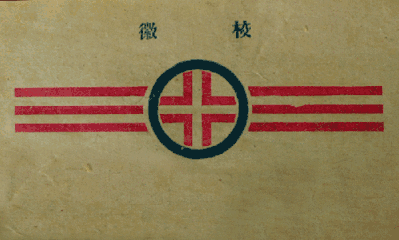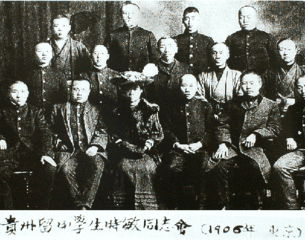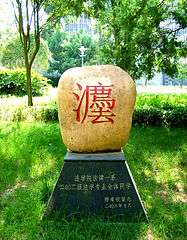Guizhou University
Guizhou University (Chinese: 贵州大学; Pinyin: Guìzhōu Dàxué), known as Guida (贵大 Guì Dà), is a provincial research university located in suburban Guiyang, capital of Guizhou, China. Founded in 1902, it is the flagship institution of higher learning in Guizhou province. With over 30,000 students, Guida is one of the largest universities in southwest China.
贵州大学 | |
 | |
| Motto | 明德至善,博学笃行 |
|---|---|
| Type | Public |
| Established | 1902 |
| President | Zheng Qiang |
| Party Secretary | Yao Xiaoquan |
Academic staff | 4,867 |
| Students | 45,000 |
| Undergraduates | 25,053 |
| Postgraduates | 4,360 |
| Location | Guiyang, Guizhou, China |
| Campus | Urban, 362.22 ha (895.1 acres)[1] |
| Colours | Red |
| Nickname | 贵大 Guì Dà |
| Website | www |
 | |

The university was selected to participate in Project 211, a government initiative which provided significant funding to elevate the research standards and faculty hiring resources of rising universities across China. In 2017, the university was recognized by the Chinese Ministry of Education as a Double First Class University, with Double First Class status in certain disciplines which the government seeks to elevate to "world-class" status.[2]
History
The predecessor of the modern Guizhou University was known as the Guizhou Institute of Higher Learning (贵州大学堂), which was founded in 1902. The institute evolved into the Provincial Guizhou University (省立贵州大学), National Guizhou College of Agriculture and Engineering (国立贵州农工学院), and finally National Guizhou University (国立贵州大学).
In 1997, the Guizhou Agricultural College, Guizhou Institute of Arts, and Guizhou Agricultural Cadre-Training School were merged into NGU to form Guizhou University.
In 2004, the Guizhou University of Technology merged into Guizhou University to complete the current Guizhou University. In 2005, the University was invited as a member of Project 211 by the Ministry of Education.
Guizhou University established a sister school relationship with the Presbyterian College in Clinton, South Carolina; the latter offers a Chinese language program for the fifteen American students every year.
Disciplines
The university consists of 39 colleges and offers programs of study in 11 academic divisions leading to associate, baccalaureate, master's, and doctoral degrees. These include:
- Agriculture
- Administration
- Economics
- Education
- Engineering
- History
- Law
- Liberal arts
- Medicine
- Philosophy
- Sciences
International cooperation and Peace Corps involvement
In 1989 Guizhou Agricultural College, then a separate university, began hosting VSO teachers in the Foreign Language Department. The following year, Guizhou University began hosting foreign teachers from the AISH programme in Australia and visiting teacher programmes in both New Zealand and the University of Alabama. Simultaneously, VSO teachers from the UK and the Netherlands were recruited to work in other Guiyang institutes of higher education including the school of fashion and the catering college, both experiencing booms concurrent with Guiyang's emergence from relative obscurity. These teachers taught in both the undergraduate and post-graduate programmes at each institution.
In 2005, eight years after Gui Nong (Guizhou Agricultural College) was merged with Gui Da (Guizhou University), Guizhou University began hosting United States Peace Corps Volunteers. The volunteers teach at both the undergraduate and graduate level in the School of Foreign Languages.
In Malaysia, Guizhou University partnered with Universiti Tunku Abdul Rahman.
Campus
Guizhou University has nine campuses situated in different locations around the city of Guiyang. The administrative center is located on the North Campus on the Huaxi River, Huaxi District of Guiyang.
Gallery
 Emblem of the National Guizhou University (国立贵州大学), 1940s.
Emblem of the National Guizhou University (国立贵州大学), 1940s. Administration Building of the National Guizhou University (国立贵州大学), 1940s.
Administration Building of the National Guizhou University (国立贵州大学), 1940s. Guizhou Students in Tokyo, Japan in 1906. Mr. Zhang Xielu (first from left in the first row) was a student of Guizhou Institute of Higher Learning (贵州大学堂)-the predecessor of Guizhou University.
Guizhou Students in Tokyo, Japan in 1906. Mr. Zhang Xielu (first from left in the first row) was a student of Guizhou Institute of Higher Learning (贵州大学堂)-the predecessor of Guizhou University. A Gift to the University from Law Students of Class 2002
A Gift to the University from Law Students of Class 2002 Department of Physics and Electronics-North Campus
Department of Physics and Electronics-North Campus
References
- "About Guizhou University, General Information". Guizhou University. Retrieved 1 February 2019.
- "教育部 财政部 国家发展改革委 关于公布世界一流大学和一流学科建设高校及建设 学科名单的通知 (Notice from the Ministry of Education and other national governmental departments announcing the list of double first class universities and disciplines)".